The Great Chunmei Dedicated to the Park
Updated:2023-09-07 Source:Shennongjia National Park
Before starting, I'd like to explain the title in details.
First of all, the “park” here is not the one in a general sense, nor some regular public leisure places located in the depths of a city or on a street and furnished with delicate artificial landscapes such as bridges, streams, pavilions, and rockeries. It refers to the Shennongjia National Park, one of the few green wonders in the world, which is situated on the 31 degrees north latitude. Hailed as the Roof of Central China, the Park boasts the traces of the earth's vicissitudes in the past 1.6 billion years, making it China's only world-class national park that is recognized as a World Biosphere Reserve, a Global Geopark, and a natural World Heritage Site by the UNESCO, and included in the List of Wetlands of International Importance and the IUCN Green List of Protected and Conserved Areas. It occupies a vast area of over 1,000 square kilometers with a forest coverage rate of over 96%. Secondly, “Chunmei” (plum blossom in early spring) in the title is not the general plum which usually grows in urban parks as a pleasant landscape and occasionally branches out towards directions. But here, it refers to Luo Chunmei, an admired retired researcher at the Science Research Institute of Shennongjia National Park. She has dedicated all her life to entomological research, especially butterfly research. Even after retiring, her great prestige still stands the test of time.
Grass in forest
For the purpose of the interview, I learned that Luo Chunmei still works in the building of the Shennongjia National Park Administration for the Shennongjia Golden Snub-nosed Monkey Conservation Foundation.
Stepping into her office, I found everything was in perfect order with flowers growing in flowerpots on the edges of her desk and on the iron shelves outside the clean windows. Even the flowerpots are in great shape. At the sight of our arrival, Luo Chunmei immediately got up and brewed up Chaoqing green tea which is reputed as the best among the local tea. With the tea fragrance mixed with stream spreading all over the office, Luo Chunmei wore a faint smile, which made her rather modest. In light of the tight schedule, we cut to the chase and started the interview which continued a long while even after she got off work. It was only when her family called her back home for supper that we came to realize our inappropriate behavior, standing up and saying goodbye to her. As we got to the door, it flashed into our mind that we hadn't added her WeChat account. Then I took out my cell phone and asked her to scan my QR code.
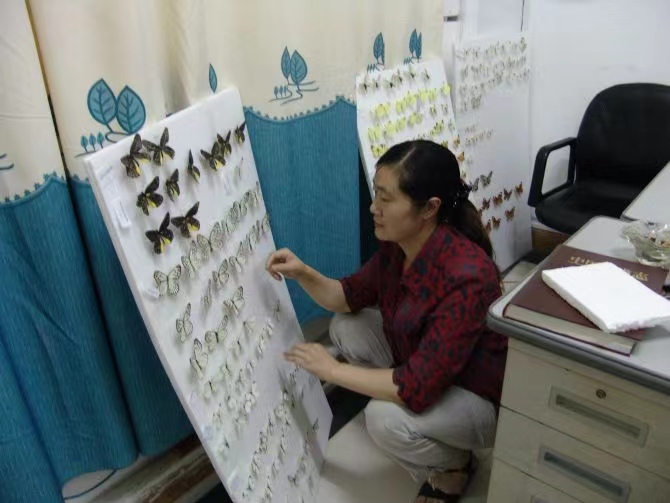 Luo Chunmei worked deep into the night
Luo Chunmei worked deep into the nightFor the purpose of the interview, I learned that Luo Chunmei still works in the building of the Shennongjia National Park Administration for the Shennongjia Golden Snub-nosed Monkey Conservation Foundation.
Stepping into her office, I found everything was in perfect order with flowers growing in flowerpots on the edges of her desk and on the iron shelves outside the clean windows. Even the flowerpots are in great shape. At the sight of our arrival, Luo Chunmei immediately got up and brewed up Chaoqing green tea which is reputed as the best among the local tea. With the tea fragrance mixed with stream spreading all over the office, Luo Chunmei wore a faint smile, which made her rather modest. In light of the tight schedule, we cut to the chase and started the interview which continued a long while even after she got off work. It was only when her family called her back home for supper that we came to realize our inappropriate behavior, standing up and saying goodbye to her. As we got to the door, it flashed into our mind that we hadn't added her WeChat account. Then I took out my cell phone and asked her to scan my QR code.
Conversion to the entomological research
After Luo Chunmei spent 12 years in the school, Shennongjia Forestry District picked up the pace. At this point, Shennongjia National Nature Reserve invested more in the conservation of natural resources and the natural environment, requiring more well-educated and ambitious young people for the research and protection of this mysterious place. Under such a circumstance, Luo Chunmei was recruited to the Shennongjia National Nature Reserve in June 2000. When it came to March 2005, inspired by the interest in and passion for animals and plants, particularly insects, she was transferred to the Scientific Research Institute at the Reserve. Not long after that, she and Wu Feng were sent by the Reserve to receive over a month of training under the guidance of Zhou Hongzhang, a professor at the Institute of Zoology, Chinese Academy of Sciences. Once back at the Reserve, Luo Chunmei participated in the first major natural resources background survey which lasted for three years. Particularly, she was responsible for the section of insects and chaired the study of insects for the Institute. After catching sight of one lovely insect after another, she couldn't resist the curiosity and intended to figure out their secrets. But later she came to realize that the world of insects is way too big and complicated. Even if she had devoted her whole life, she couldn't understand a small part of it. That's why she has concentrated on the study of butterflies.
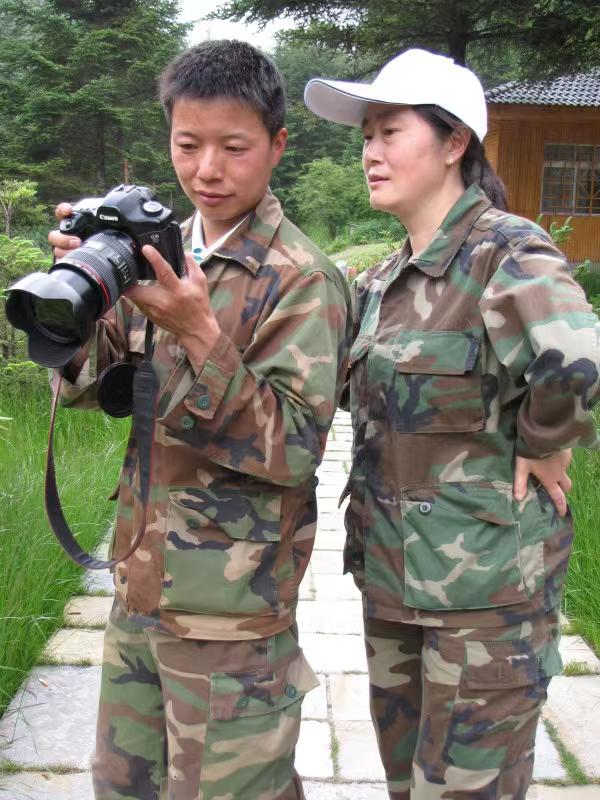 Luo Chunmei(Right)and her colleague Wu Feng checked photos of butterflies
Luo Chunmei(Right)and her colleague Wu Feng checked photos of butterflies“Seriously, at that time, my perception of insects was all based on the textbook of Natural Science. It was way too limited while the world of insects is extremely overwhelming!” said Luo Chunmei. At the very beginning of the study, she was confronted with tough conditions, such as outdated devices for the capture of butterflies, development and enlargement of films as the cameras were non-digital, underdeveloped Internet conditions, and serious inconvenience to turn to relevant scholars or experts for help. But even with that, she managed to take one step after another. Starting from the capture of butterflies, she learned how to create specimens and preserve their materials. Whenever coming across difficulties, she found ways to contact experts for help, such as making repeated phone calls and sending emails, until she figured out every link. Given that her child attended the boarding school, Luo Chunmei spent all the time studying in mountains. Besides, she was scared of nothing even if falling down seriously from the tree or being stung badly by hornets after kicking their nest by mistake.
After another 12 years, Luo Chunmei hung tens of thousands of butterfly specimens throughout her lab, which was also packed with numerous test tubes and other containers with diverse pupae and larvae inside. When it came to two years before her retirement, she determined to weave together all her findings into a book that would serve as a reference for later research on the butterflies in the Reserve.
Strong ambition remaining even after her retirement
Luo Chunmei's writing - Butterflies in Shennongjia Area, one of the natural resources scientific investigation series published by China Forestry Publishing House, together with her introduction ranks top when we search Luo Chunmei in 360 Search, a Chinese search engine. On the top of the book cover reads two rows of Chinese characters which means the book is supported by the National Key Technology Research and Development Program of the Ministry of Science and Technology of China and the Open Fund of Hubei Province Key Laboratory of Conservation Biology for Shennongjia Golden Snub-nosed Monkey, which tells the significance of the writing.
The book falls into General and Specific Discussion, which encompasses two chapters and 17 sections in total. The entire writing presents the world of butterflies with an incredibly wide spectrum of their categories.
In spite of this major writing, Luo Chunmei's contributions to the biodiversity of the Shennongjia Forestry District are more than the study of butterflies. In this aspect, Yang Jingyuan, director of the Science Research Institute of Shennongjia National Park, said: “The author collected over 80,000 insect specimens during her blind-zone-free investigation on the resources of insects in Shennongjia Forestry District. Together with the previous findings, she counted that the insect class in the area fell into 28 orders and 4,318 species. Among them, 42 genera and 121 species were newly recorded in Hubei Province while 12 families, 153 genera, and 333 species of butterflies were found in Shennongjia Forestry District.” In other words, entomological research is also Luo Chunmei's top concern. She argued that since the Shennongjia Forestry District can be described as a kingdom of insects and is home to numerous and infinite insects, it deserves professional teams for the research.
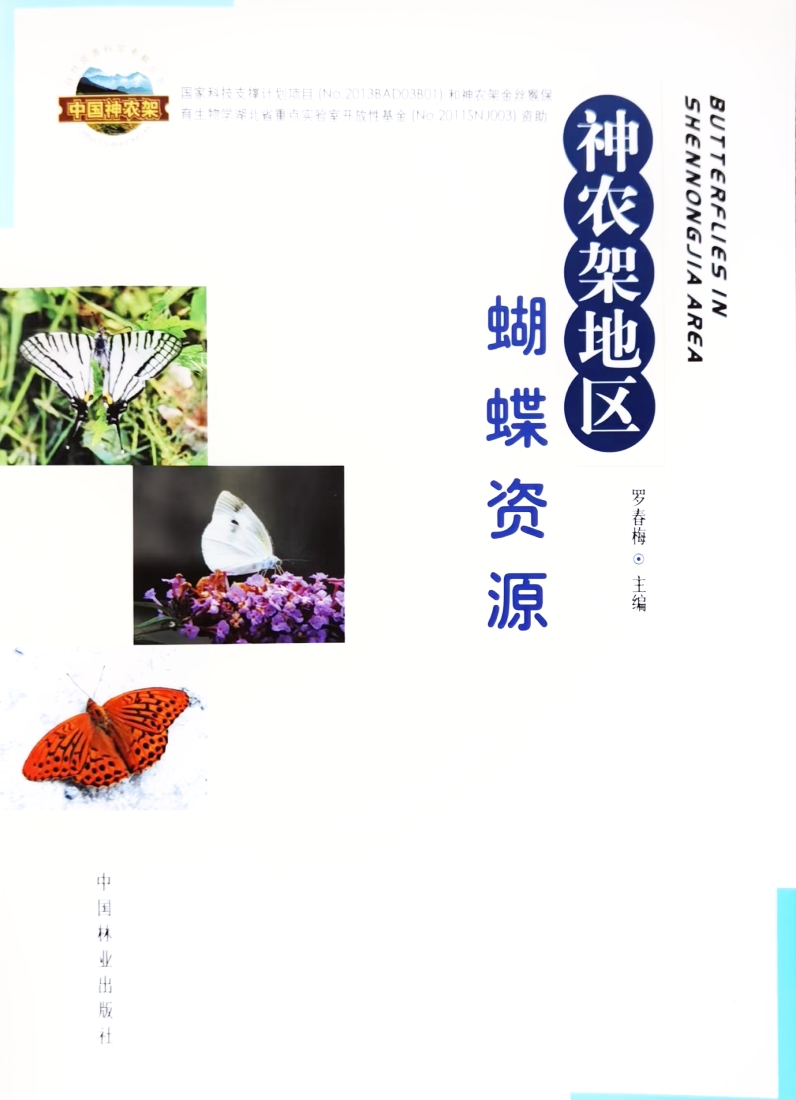
From her perspective, biodiversity researchers are supposed to choose their own specific fields and dedicate themselves to studying and revealing the mystery of creatures in the natural world. That's how they push forward applied disciplines and leverage the laws of nature to preserve Mother Nature. She expressed that the work in the Shennongjia National Park for over two decades has been the most valuable part of her life. The colleagues there are her friends and mentors. It is this experience that has transfigured her strength and passion and made her dreams come true.
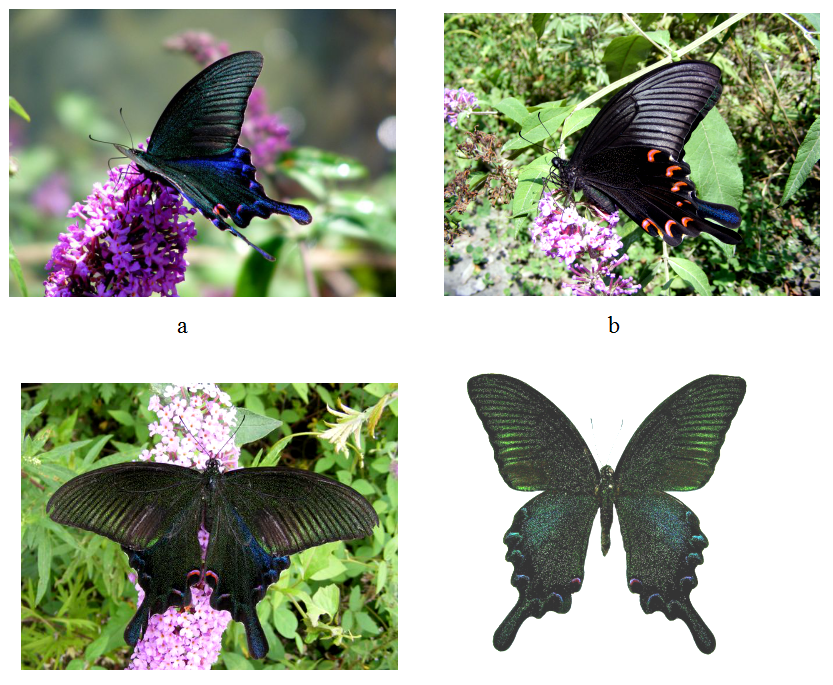 Papilio bianor Cramer
Papilio bianor Cramer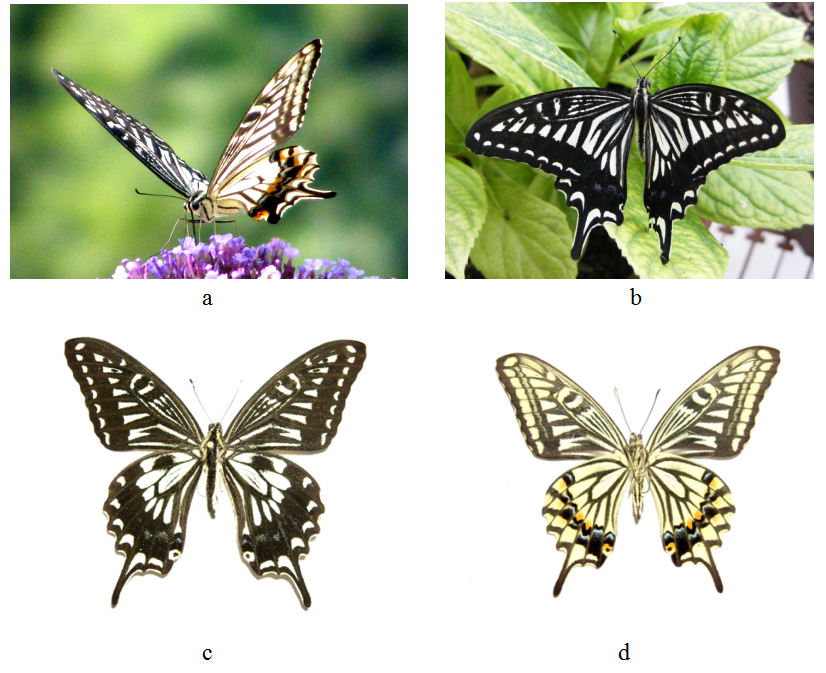 Papilio xuthus Linnaeus
Papilio xuthus LinnaeusIn spite of her retirement, Luo Chunmei has remained concerned about the research on butterflies. “I'm assisting Wei Cong, a professional at Northwest A&F University, in capturing butterflies with the hope of new findings,” said Luo Chunmei, “Every year, the Shennongjia Forestry District witnesses the reactivation of many hairstreaks and white butterflies starting from late March, the most vigorous span of all butterflies from May to July, and the dominance of swallowtail butterflies with big sizes and the gradual disappearance of the rest since August. In short, butterflies can be seen throughout the whole year in the area. Even in the frozen bleakness, they can sometimes fly in the air as long as there is a little sunlight.” With these few words, she clearly summed up the regular routine of local butterflies.
Despite her profound research, Luo Chunmei still believes her study is quite superficial and all her achievements should be credited to the whole team of the Institute. She hopes that the butterflies in the area can be further popularized to achieve the research value and the science popularization value. From every aspect, Luo Chunmei and her deep attachment to butterflies deserve to write home about. Besides, her research means a lot to both the scientific work of the Institute and the study and preservation of the resources of butterflies in China.(By/Joseph Ma Jessie Ning & Wang Ping)
Copyright Shennongjia National Park
Address:36 Chulin Road, Muyu Town, Shennongjia Forestry District, Hubei Province 鄂ICP备18005077号-3
Address:36 Chulin Road, Muyu Town, Shennongjia Forestry District, Hubei Province 鄂ICP备18005077号-3
Email:2673990569@qq.com
Phone:0719-3453368
Phone:0719-3453368


TOP

